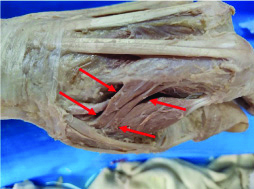Letter to the Editor: Presence of Supernumerary First Dorsal Interossei Muscle
Debra Kusnierek1
1 Occupational Therapy Doctoral Student (OTDS), Department of Occupational Therapy Doctoral Program, Huntington University, Fort Wayne, Indiana, USA.
NAME, ADDRESS, E-MAIL ID OF THE CORRESPONDING AUTHOR: Debra Kusnierek, 91 East Sidlee Street, Thousand Oaks, California, USA.
E-mail: kusnierekd@huntington.edu
Cadaveric study,Dorsal interosseous,Metacarpal bone,Radial side,Ulnar side
Dear Editor,
In the June 2016 issue of this Journal, Nayak VS et al., [1] published, “Cadaveric Study on Morphology of Dorsal Interossei of Hand and its Anatomical Variation”. Three out of the 30 dissected hands had a supernumerary muscle originating from the third metatarsal. During the dissection within the Occupational Therapy Program at Huntington University in Fort Wayne, Indiana, the author identified a supernumerary first left Dorsal Interossei Muscle (DIM) [Table/Fig-1]. The unusual variation could not be identified on the right upper extremity. This variant should thus be added to the one by Nayak VS et al., [1].
Accessory first dorsal interosseous (arrows) arising from the ulnar side first metacarpal bone and inserting into the radial side of the second metacarpal bone.

Masquelet AC et al., stated that the superficial head of the first DIM primarily causes abduction, whereas the deep head causes thumb and index finger flexion to form a pinch [2]. The DIMs of the hand also act as stabilisers for the fingers during grasping and manipulation [3]. The accessory head which the author identified will most likely to provide an increase in pinch strength, which is important for manual exploration of an object, along with identification. Fine motor skills can orient an object, stabilise it, and transfer it to a desired location [4]. Susman RL et al., analysed the potential functional purpose of musculus accessories interosseus, a unique muscle found in lesser apes that originates from the second metacarpal and inserts distally into the extensor assembly; they suggested that it evolved to compensate for the deep cleft found between the thumb and index finger in lesser apes [5]. Results of Susman RL et al., Electromyogram (EMG) analysis showed that the accessorius interosseus functions mainly to abduct the index finger during pinching and grasping of objects [5]. The supernumerary first DIM, we identified may function in a similar manner for humans.
[1]. Nayak VS, Priya A, Bhat N, Nayak SS, D’Souza AS, Bangera H, Cadaveric study on morphology of dorsal interossei of hand and its anatomical variation J Clin Diagn Res: JCDR 2016 10(6):AC04-06.https://doi.org/10.7860/JCDR/2016/19068.803410.7860/JCDR/2016/19068.803427504270 [Google Scholar] [CrossRef] [PubMed]
[2]. Masquelet AC, Salama J, Outrequin G, Serrault M, Chevrel JP, Morphology and functional anatomy of the first dorsal interosseous muscle of the hand Surgical and Radiological Anatomy 1986 8(1):19-28.10.1007/BF025397043088742 [Google Scholar] [CrossRef] [PubMed]
[3]. Bharambe VK, Shevde SP, Puranam V, Kanaskar NS, Additional heads of dorsal interosseous muscle in Caucasian cadavers and their clinical significance Sahel Medical Journal 2013 16(4):174-77.10.4103/1118-8561.125580 [Google Scholar] [CrossRef]
[4]. Kimmerle M, Mainwaring L, Borenstein M, The functional repertoire of the hand and its application to assessment American Journal of Occupational Therapy 2003 57(5):489-98.https://doi.org/10.5014/ajot.57.5.48910.5014/ajot.57.5.48914527110 [Google Scholar] [CrossRef] [PubMed]
[5]. Susman RL, Jungers WL, Stern JT Jr, The functional morphology of the accessory interosseous muscle in the gibbon hand: Determination of locomotor and manipulatory compromises Journal of Anatomy 1982 134(1):111-20. [Google Scholar]